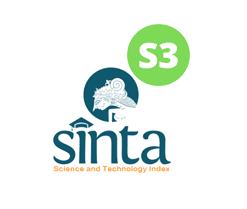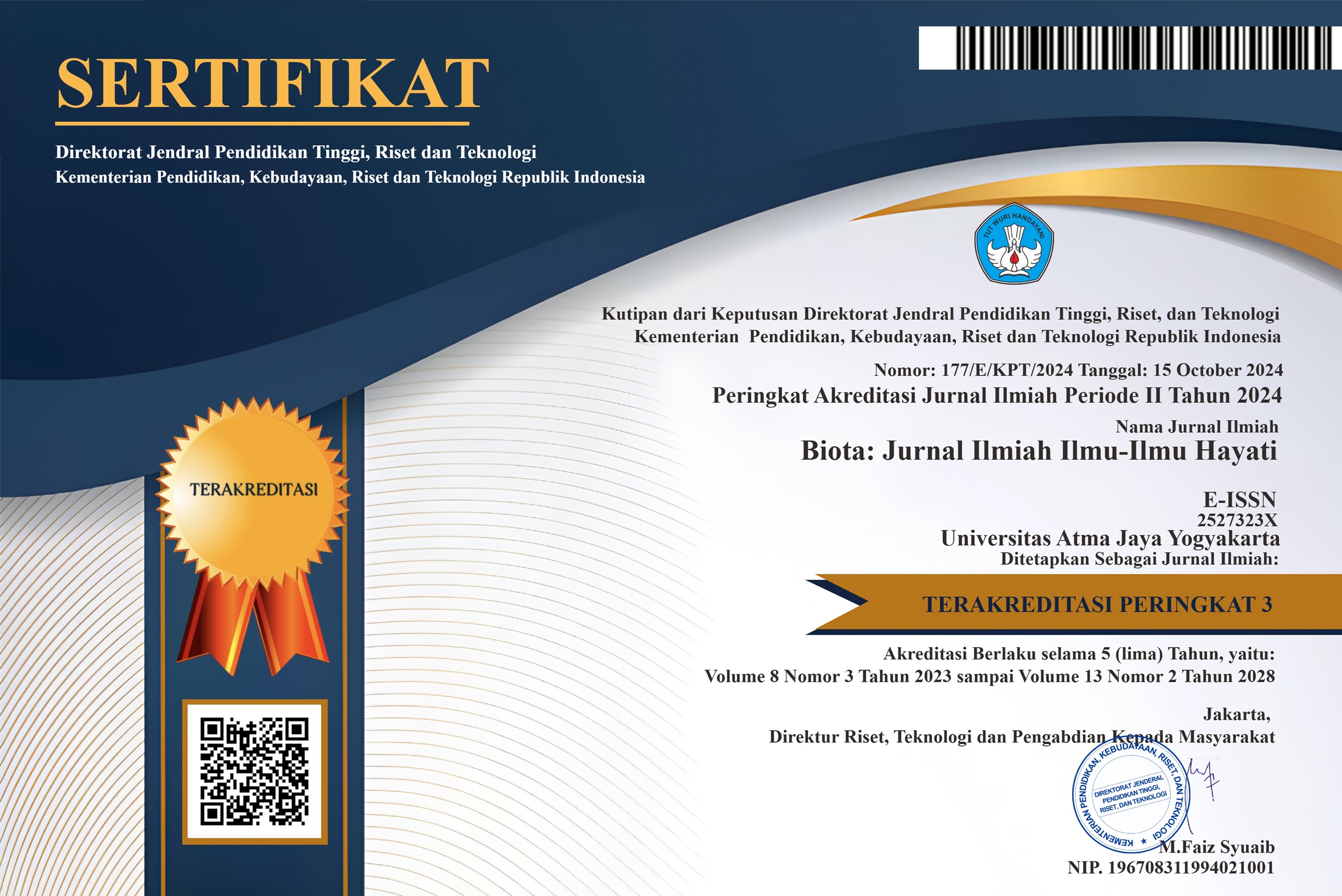Uji Efek Inhibitorik Komponen Bioaktif Bawang Putih (Allium sativum) terhadap Lanosterol 14α-demethylase pada Candida albicans melalui Studi In Silico
DOI:
https://doi.org/10.24002/biota.v5i2.2940Keywords:
Gallic Acid, Candidiasis, Candida albicans, lanosterol 14α-demethylaseAbstract
Candida albicans is a unicellular fungi which causes candidiasis in human and livestock animals especially chicken. Candidiasis could reduce productivity significantly by early culling and causing a great deficit in the farm. Allium sativum or garlic is widely known as herbal which has an inhibitory effect in fungi’s growth. This research’s aim is to prove the effectivity of bioactive compound in Allium sativum to lanosterol 14α-demethylase which plays a role in ergosterol synthesis as a basic structure in fungi’s cell membrane. The ligand sheet retrieved from PubChem database and for the receptor in Protein Data Bank database. Molecular docking conducted by using Autodock Vina and then ligand-receptor complex is visualized with PyMOL and Ligplot+. From compounds that we have been analyzed, Gallic Acid has the most negative binding energy than other compounds have and it has the same amino acid residue with control. In conclusion of that, Gallic Acid in Allium sativum has potential as anti-candidiasis drug.
References
Aoyama, Y., Yoshida, Y., & Sato, R. (1984). Yeast cytochrome P-450 catalyzing lanosterol 14 alpha-demethylation. II. Lanosterol metabolism by purified P-450 (14) DM and by intact microsomes. Journal of Biological Chemistry, 259(3), 1661-1666.
Basis Data Tanaman Obat Indonesia. http://herbaldb.farmasi.ui.ac.id/v3/, diakses 12 Juni 2019
Calderone, R. A., & Fonzi, W. A. (2001). Virulence factors of Candida albicans. Trends in microbiology, 9(7), 327-335.
Djaenuddin G. Pengujian penggunaan ekstrak etanol bawang putih (Allium sativum L.) terhadap kelinci yang diinfeksi dermatofit Trichophyton mentafrophytes. Seminar Teknologi Peternakan dan
Veteriner; 2010, Balai Besar Penelitian Veteriner. p. 803-8
Eni K. Mekanisme infeksi Candida albicans pada permukaan sel. Lokakarya Nasional Penyakit Zoonis; 2010, Balai Besar Penelitian Veterenier. p. 304-13
Hann, I. M., Corringham, R., Keaney, M., Noone, P., Fox, J., Szawatkowski, M., & Boesen, E. (1982). Ketoconazole versus nystatin plus amphotericin B for fungal prophylaxis in severely immunocompromised patients. The Lancet, 319(8276), 826-829.
Kharisma, V. D., Septiadi, L., & Syafrudin, S. (2018). Prediction of Novel Bioactive Compound from Zingiber officinale as Non-nucleoside Reverse Transcriptase Inhibitors (NNRTIs) of HIV-1 through Computational Study. Bioinformatics and Biomedical Research Journal, 1(2), 49-55.
Kim S, Thiessen PA, Bolton EE, Chen J, Fu G, Gindulyte A, Han L, He J, He S, Shoemaker BA, Wang J, Yu B, Zhang J, Bryant SH. 2016. PubChem Substance and Com-pound databases. Nucleic Acids Res. 44 (D1): D1202-13. doi: 10.1093/nar/gkv951.
Kutawa, A. B., Danladi, M. D., & Haruna, A. (2018). Antifungal Activity of Garlic (Allium sativum) Extract on Some Selected Fungi. Journal of Medicinal Herb and Etnomedicine Vol. 4, 12-14.
Laskowski RA & Swindells MB. 2011. LigPlot+: multiple ligand-protein interaction diagrams for drug discovery. J. Chem. Inf. Model 51: 2778-2786.doi: 10.1021/ci200227u.
Sari, M. E. S. Y. I. A. (2014). Pengaruh Perendaman Bahan Basis Gigi tiruan Valplast dalam Larutan Ekstrak Bawang Putih terhadap Pertumbuhan Candida albicans. Skripsi. FKG Universitas Hasanuddin, 20-17.
Seeliger D, & de Groot BL. 2010. Ligand docking and bind-ing site analysis with PyMOL and Autodock/Vina. Journal of computer-aided molecular design 24(5): 417-422. doi: 10.1007/s10822-010-9352-6.
The Protein Databank. http://www.rcsb.org/pdb/home/home.do. diakses 12 Juni 2019.
Trösken, E. R., Adamska, M., Arand, M., Zarn, J. A., Patten, C., Völkel, W., & Lutz, W. K. (2006). Comparison of lanosterol-14α-demethylase (CYP51) of human and Candida albicans for inhibition by different antifungal azoles. Toxicology, 228(1), 24-32.
Trott, O., & Olson, A. J. (2010). AutoDock Vina: improving the speed and accuracy of docking with a new scoring function, efficient optimization, and multithreading. Journal of computational chemistry, 31(2), 455-461.
Downloads
Published
How to Cite
Issue
Section
License
Copyright (c) 2021 Aditya Tri Ananda, Alsya Firdausi Nuzula, Devi Ayu Safitri

This work is licensed under a Creative Commons Attribution-NonCommercial 4.0 International License.
Authors who publish with Biota : Jurnal Ilmiah Ilmu-Ilmu Hayati agree to the following terms:
- Authors retain copyright and grant the Biota : Jurnal Ilmiah Ilmu-Ilmu Hayati right of first publication. Licensed under a Creative Commons Attribution-NonCommercial 4.0 International License that allows others to share the work with an acknowledgment of the work's authorship and initial publication in this journal.
- Authors are able to enter into separate, additional contractual arrangements for the non-exclusive distribution of the journal's published version of the work (e.g., post it to an institutional repository or publish it in a book), with an acknowledgment of its initial publication in Biota : Jurnal Ilmiah Ilmu-Ilmu Hayati, and as long as Author is not used for commercial purposes.













